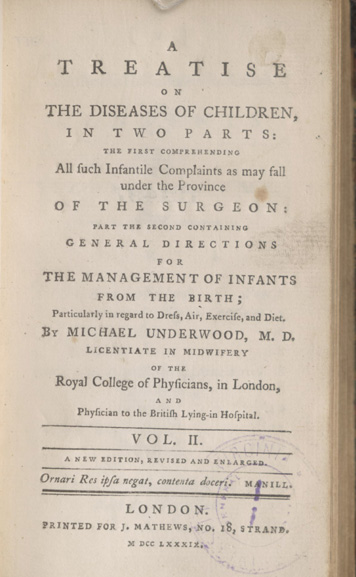The Molesey Physician who defined Polio.
Michael Underwood was born in West Molesey of respectable parents on the 29 September 1737. He received a good education, first at West Molesey School and then at Kensington in London. Planning to enter the medical profession, he came under the tuition of the eminent surgeon Sir Caesar Hawkins (sergeant‐surgeon to George II), who introduced him as a house pupil to St George’s Hospital, where he remained for several years. Later he expressed his indebtedness to this “long residence in one of the largest and best conducted hospitals in the metropolis”.
After a sojourn in Paris, Underwood became a member of the Surgeon’s Company and established himself in practice in Margaret Street, Cavendish Square, combining surgery with the practice of obstetrics. Later he was appointed surgeon to the British Lying‐in Hospital in London He is a relevant figure in the history of medicine and paediatrics for having given the first known description of several childhood diseases, infantile paralysis included.
In 1783 he published his first work, which was about leg ulcers and “in which former methods of treatment were candidly examined and compared, with one more rational and safer, proving that a perfect cure may generally be effected more certainly, without rest and confinement, than by the strict regimen in common use.” This work was reviewed in The English Review, where it was written favourably:
In 1789, he became the first person to give a clinical description of Polio, which he referred to as “a debility of the lower extremities.” He was later elected a member of the Royal College of Physicians in London.
In 1796, Underwood was chosen as accoucheur at the birth of the Princess Charlotte of Wales. In 1801, he fell sick and retired from his profession. That time was economically difficult for him, but, as a religious man, he later “regained its healthy tone, and he was enabled to realize the hopes and consolations of the Gospel”
In 1824, a collection of thoughts from his diary was published posthumously for the benefit of his widowed daughter. The full name of this book was Extracts from the Diary of the late Michael Underwood, M.D. consisting of Mediation, Critical and Practical Remarks on various Passages of Scripture, Miscellaneous Essays, and Occasional Hymns. A review from The Literary Chronicle read that:
It embraces a period of more than sixty years, during which it was the constant practice of Dr. Underwood to commit to paper the occurrences of each day for his own personal gratification; his domestic circumstances, professional visits, religious impressions, and Christian duties, were all entered as in a day-book without any regard to order or arrangement
A review of the book in The Monthly Repository described the physician as “a man of sincere and deep piety; his creed was highly Calvinistic.” The work was said to be mournful at times, and another review in The London Literary Gazette said that “its author seems to have overshadowed and bewildered his mind by painful metaphysical contemplation of the greatest mysteries of religion; but he displays a Christian, if a too intense, anxiety to arrive at truth and satisfy his soul.” He was buried in Whitefield’s Tabernacle, Tottenham Court Road in London.

